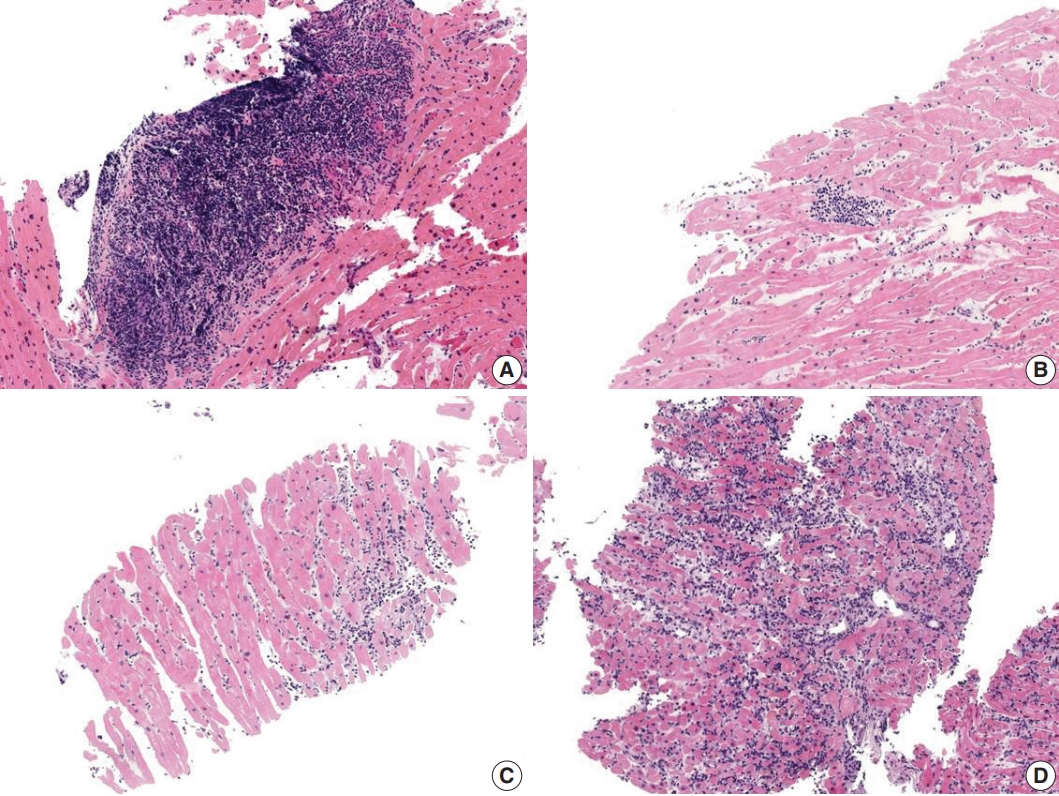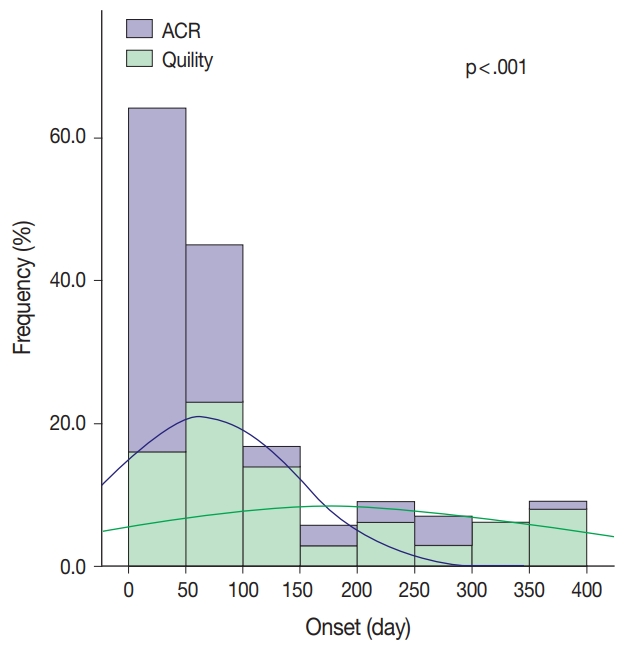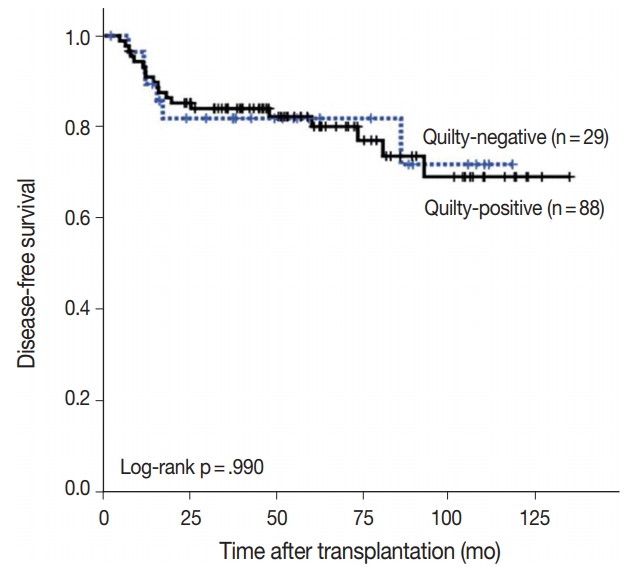Articles
- Page Path
- HOME > J Pathol Transl Med > Volume 53(1); 2019 > Article
-
Original Article
Quilty Lesions in the Endomyocardial Biopsies after Heart Transplantation -
Haeyon Cho1
 , Jin-Oh Choi2
, Jin-Oh Choi2 , Eun-Seok Jeon2
, Eun-Seok Jeon2 , Jung-Sun Kim1,3
, Jung-Sun Kim1,3
-
Journal of Pathology and Translational Medicine 2019;53(1):50-56.
DOI: https://doi.org/10.4132/jptm.2018.11.30
Published online: December 26, 2018
1Department of Pathology and Translational Genomics, Samsung Medical Center, Sungkyunkwan University School of Medicine, Seoul, Korea
2Division of Cardiology, Department of Medicine, Samsung Medical Center, Sungkyunkwan University School of Medicine, Seoul, Korea
3Department of Health Sciences and Technology, Sungkyunkwan University, SAIHST, Seoul, Korea
- Corresponding Author Jung-Sun Kim, MD, PhD Department of Pathology and Translational Genomics, Samsung Medical Center, Sungkyunkwan University School of Medicine, 81 Irwon-ro, Gangnam-gu, Seoul 06351, Korea Tel: +82-2-3410-2767 Fax: +82-2-3410-0025 E-mail: jsunkim@skku.edu
© 2019 The Korean Society of Pathologists/The Korean Society for Cytopathology
This is an Open Access article distributed under the terms of the Creative Commons Attribution Non-Commercial License (http://creativecommons.org/licenses/by-nc/4.0) which permits unrestricted non-commercial use, distribution, and reproduction in any medium, provided the original work is properly cited.
Figure & Data
References
Citations

- The roles of tertiary lymphoid structures in orchestrating immune responses in peripheral organs
Keisuke Taniguchi, Takahisa Yoshikawa, Motoko Yanagita
Inflammation and Regeneration.2025;[Epub] CrossRef - The human myocardium harbors a population of naive B-cells with a distinctive gene expression signature conserved across species
Kevin C. Bermea, Nicolas Kostelecky, Sylvie T. Rousseau, Chieh-Yu Lin, Luigi Adamo
Frontiers in Immunology.2022;[Epub] CrossRef - Examination of tracheal allografts after long-term survival in dogs
Tao Lu, Yiwei Huang, Yulei Qiao, Yongxing Zhang, Yu Liu
European Journal of Cardio-Thoracic Surgery.2021; 59(1): 155. CrossRef - Essentials in the diagnosis of postoperative myocardial lesions similar to or unrelated to rejection in heart transplant
Costel Dumitru, Ancuta Zazgyva, Adriana Habor, Ovidiu Cotoi, Horațiu Suciu, Carmen Cotrutz, Bogdan Grecu, Ileana Anca Sin
Revista Romana de Medicina de Laborator.2021; 29(3): 307. CrossRef - Clinical outcome of donor heart with prolonged cold ischemic time: A single‐center study
Fazal Shafiq, Yixuan Wang, Geng Li, Zongtao Liu, Fei Li, Ying Zhou, Li Xu, Xingjian Hu, Nianguo Dong
Journal of Cardiac Surgery.2020; 35(2): 397. CrossRef - The XVth Banff Conference on Allograft Pathology the Banff Workshop Heart Report: Improving the diagnostic yield from endomyocardial biopsies and Quilty effect revisited
Jean-Paul Duong Van Huyen, Marny Fedrigo, Gregory A. Fishbein, Ornella Leone, Desley Neil, Charles Marboe, Eliot Peyster, Jan von der Thüsen, Alexandre Loupy, Michael Mengel, Monica P. Revelo, Benjamin Adam, Patrick Bruneval, Annalisa Angelini, Dylan V. M
American Journal of Transplantation.2020; 20(12): 3308. CrossRef
 PubReader
PubReader ePub Link
ePub Link-
 Cite this Article
Cite this Article
- Cite this Article
-
- Close
- Download Citation
- Close
- Figure





Fig. 1.
Fig. 2.
Fig. 3.
Fig. 4.
Fig. 5.
| Grade | Definition |
|---|---|
| Grade 0R |
No rejection |
| Grade 1R |
Interstitial and/or perivascular infiltrate with up to 1 focus of myocyte damage |
| Grade 2R |
Two or more foci of infiltrate with associated myocyte damage |
| Grade 3R |
Diffuse infiltrate with multifocal myocyte damage ± edema, ± hemorrhage ± vasculitis |
| Characteristic | Total (n = 117) | Quilty-positive (n = 88) | Quilty-negative (n = 29) |
|---|---|---|---|
| Age at heart transplantation (yr) | 46.6 | 46.2 | 47.8 |
| Sex | |||
| Male | 73 (62.4) | 54 (61.4) | 19 (65.5) |
| Female | 44 (37.6) | 34 (38.6) | 10 (34.5) |
| Cause of heart failure | |||
| DCMP | 86 (73.5) | 65 (73.9) | 21 (72.4) |
| Ischemic heart disease | 16 (13.7) | 13 (14.8) | 3 (10.3) |
| HCMP | 7 (6.0) | 6 (6.8) | 1 (3.4) |
| Others | 8 (6.8) | 4 (4.5) | 4 (13.8) |
| No. of EMBs | 10.2 | 10.4 | 9.5 |
| Follow-up period (mo) | 55.7 | 55.7 | 55.4 |
| Clinical outcome | Quilty-positive (n = 88) | Quilty-negative (n = 29) | p-value |
|---|---|---|---|
| Acute cellular rejection | |||
| Any ACR | 82 (93.2) | 21 (72.4) | .006 |
| ACR ≥ 2R | 23 (26.1) | 5 (17.2) | .697 |
| Antibody mediated rejection | 11 (12.5) | 4 (13.8) | > .990 |
| Cardiac allograft vasculopathy | |||
| Any CAV | 38 (43.2) | 5 (17.2) | .012 |
| Significant CAV | 13 (14.8) | 0 | .036 |
| Univariate analysis |
Multivariate analysis |
|||||
|---|---|---|---|---|---|---|
| HR | 95% CI | p-value | HR | 95% CI | p-value | |
| Quilty lesion | 1.006 | 0.401–2.521 | .990 | - | - | - |
| Antibody meditated rejection | 5.048 | 2.222–11.470 | < .001 |
4.185 | 1.510–11.598 | .006 |
| Any ACR | 3.136 | 0.424–23.187 | .263 | - | - | - |
| ACR ≥ 2R | 2.424 | 1.081–4.437 | .032 |
- | - | - |
| Any CAV | 0.550 | 0.229–1.323 | .550 | - | - | - |
| Significant CAV | 2.564 | 1.057–6.220 | .037 |
- | - | - |
| Age at transplantation | 0.973 | 0.951–0.995 | .019 | - | - | - |
| History of dialysis | 1.527 | 0.570–4.085 | .400 | - | - | - |
| History of DM | 1.862 | 0.737–4.709 | .189 | - | - | - |
| VAD at time of transplantation | 2.359 | 1.069–5.206 | .034 |
- | - | - |
| Ventilator at time of transplantation | 5.609 | 2.470–12.736 | < .001 |
- | - | - |
| PRA > 20% | 2.500 | 1.139–5.486 | .022 |
- | - | - |
ISHLT, International Society for Heart and Lung Transplantation. “R” denotes revised grade to avoid confusion with 1990 scheme.
Values are presented as mean or number (%). DCMP, dilated cardiomyopathy; HCMP, Hypertrophic cardiomyopathy; EMB, endomyocardial biopsy.
Values are presented as number (%). ACR, acute cellular rejection; CAV, cardiac allograft vasculopathy. Statistically significant (p < .05).
HR, hazard ratio; CI, confidence interval; ACR, acute cellular rejection; CAV, cardiac allograft vasculopathy; DM, diabetes mellitus; VAD, ventricular assist device; PRA, panel reactive antibody. Statistically significant (p < .05).

 E-submission
E-submission












